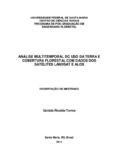| dc.creator | Torres, Daniela Ricalde | |
| dc.date.accessioned | 2012-03-06 | |
| dc.date.available | 2012-03-06 | |
| dc.date.issued | 2011-07-29 | |
| dc.identifier.citation | TORRES, Daniela Ricalde. Multitemporal analysis of land use and forest coverage with data from LANDSAT and ALOS satellites. 2011. 97 f. Dissertação (Mestrado em Recursos Florestais e Engenharia Florestal) - Universidade Federal de Santa Maria, Santa Maria, 2011. | por |
| dc.identifier.uri | http://repositorio.ufsm.br/handle/1/8688 | |
| dc.description.abstract | The monitoring of the use and coverage is very important when studying determined
regions, just because it helps knowing the environmental reality and contributes to
solve problems that can probably appear. This research was done from the images
of ALOS and LANDSAT satellites. Its main objective was to have a multi-temporal
analysis of Arroio Grande micro watershed, central region of Rio Grande do Sul. The
specific purposes were to identify and to quantify the different classes of land use
found in this micro watershed along the 1987, 1998, 2002, 2005, 2007 and 2009
periods, as well as cross the land use information to show the forest coverage
changes during the 22 years of analysis. The software SPRING 5.1.7 was employed
to classify the supervised images through Bhattacharya, a sorter algorithm, and the
map spatial analysis was done through the Spatial Language of Algebraic
Geoprocessing program with the same computational application. The classes of
land use as forest, field, agriculture, irrigated agriculture, exposed soil and water
layer were observed in the images of each year in this analysis. These classes were
utilized in the spatial analysis of the forest coverage in which forest monitoring
parameters have been defined (forest maintenance and regeneration, deforestation).
In this research the principal results that have been noticed were the increase of
17,98% on the distributed forest coverage, mainly in the areas of bigger declination,
and the reduction of 16,32% on the field area. The analysis of the spatial forest
coverage has presented stability with the landscape, in a gradual progression,
because the area of forest maintenance, found in these 22 years, was 12.252,60ha,
the forest regeneration was 4.389,12ha and only 1.853,82ha of deforested area. | eng |
| dc.description.sponsorship | Conselho Nacional de Desenvolvimento Científico e Tecnológico | |
| dc.format | application/pdf | por |
| dc.language | por | por |
| dc.publisher | Universidade Federal de Santa Maria | por |
| dc.rights | Acesso Aberto | por |
| dc.subject | Classificação supervisionada | por |
| dc.subject | Uso da terra | por |
| dc.subject | Análise espacial | por |
| dc.subject | Sensoriamento remoto | por |
| dc.subject | Análise multitemporal | por |
| dc.subject | Microbacia | por |
| dc.subject | Supervised classification | eng |
| dc.subject | Land use | eng |
| dc.subject | Spatial analysis | eng |
| dc.subject | Remote sensing | eng |
| dc.subject | Multi-temporal analysis | eng |
| dc.subject | Micro watershed | eng |
| dc.title | Análise multitemporal do uso da terra e cobertura
florestal com dados dos satélites LANDSAT e ALOS | por |
| dc.title.alternative | Multitemporal analysis of land use and forest
coverage with data from LANDSAT and ALOS satellites | eng |
| dc.type | Dissertação | por |
| dc.description.resumo | O monitoramento do uso e cobertura da terra faz-se importante no estudo de
determinadas regiões, pois auxilia no conhecimento da realidade ambiental e
contribui na busca por soluções de problemas que possam se apresentar. A partir do
uso de imagens dos satélites, ALOS e LANDSAT, foi realizada esta pesquisa com o
objetivo principal de fazer uma análise multitemporal na microbacia do Arroio
Grande, região central do Rio Grande do Sul, cujos objetivos específicos foram:
Identificar e quantificar as diferentes classes de uso da terra encontradas na
microbacia nos períodos de 1987, 1998, 2002, 2005, 2007 e 2009; além de cruzar as
informações de uso da terra, evidenciando a cobertura florestal que sofreu
alterações no decorrer dos 22 anos de análise. Para tanto, foram utilizados o
software SPRING 5.1.7 para a classificação supervisionada das imagens, com a
adoção do algoritmo classificador Bhattacharya, e a análise espacial dos mapas com
a programação LEGAL do mesmo aplicativo computacional. Para esta análise, foram
observadas as classes de uso do solo: floresta, campo, agricultura, agricultura
irrigada, solo exposto e lâmina d água, nas imagens de cada ano. Estas classes
foram empregadas na análise espacial da cobertura florestal em que foram definidos
parâmetros para o monitoramento florestal (manutenção florestal, regeneração
florestal e desmatamentos). Os principais resultados notados, nesta pesquisa, foram
o aumento de 17,98% na cobertura florestal distribuída, principalmente, nas áreas de
maiores declividade, e a redução de 16,32% sobre a área de campo. Quanto à
análise espacial da cobertura florestal, esta mostrou-se em estabilidade com a
paisagem, e em gradual progressão, pois a área de manutenção florestal
encontrada, nestes 22 anos, foi de 12.252,60 ha, a regeneração florestal foi de
4.389,12 ha e apenas 1.853,82 ha de área desmatada. | por |
| dc.contributor.advisor1 | Pereira, Rudiney Soares | |
| dc.contributor.advisor1Lattes | http://lattes.cnpq.br/9479801378014588 | por |
| dc.contributor.referee1 | Lingnau, Christel | |
| dc.contributor.referee1Lattes | http://lattes.cnpq.br/0584915731374399 | por |
| dc.contributor.referee2 | Longhi, Solon Jonas | |
| dc.contributor.referee2Lattes | http://lattes.cnpq.br/2401814326298046 | por |
| dc.creator.Lattes | http://lattes.cnpq.br/8880742771579487 | por |
| dc.publisher.country | BR | por |
| dc.publisher.department | Recursos Florestais e Engenharia Florestal | por |
| dc.publisher.initials | UFSM | por |
| dc.publisher.program | Programa de Pós-Graduação em Engenharia Florestal | por |
| dc.subject.cnpq | CNPQ::CIENCIAS AGRARIAS::RECURSOS FLORESTAIS E ENGENHARIA FLORESTAL | por |


